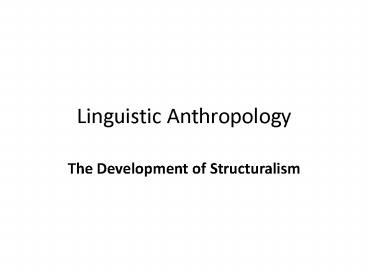Linguistic Anthropology PowerPoint PPT Presentation
1 / 15
Title: Linguistic Anthropology
1
Linguistic Anthropology
- The Development of Structuralism
2
Wilhelm von Humboldt
- Language is the medium through which humans
perceive the world - There is a relationship between a nations
language and its character
(1767 1835)
3
Wilhelm von Humboldt
- The outer form of a language consists of the
raw material the sounds used to make
different languages - The inner form is the pattern the structure
of the grammar and the meanings given to the
raw material - It is the inner form that distinguishes
languages from one another
Wilhelm von Humboldt (ca. 1830)
4
Wilhelm von Humboldt
- Language is dynamic, not static.
- Language is an activity, not a product of
activity. - A language is not a set of actual utterances
produced by speakers - It is the underlying principles or rules that
made it possible for speakers to produce such
utterances. - A Structural conception of language.
5
Ferdinand de Saussure
- Language is a structured system that can be
viewed - synchronically (as it exists at any one time)
- diachronically (as it changes over time)
(18571913)
6
Ferdinand de Saussure
- parole the way a particular person speaks
- langue the system of rules that makes it
possible for a person to know how to speak - parole
parole
parole
langue
parole
parole
parole
7
Ferdinand de Saussure on Signs
- Language is a symbolic system that depends upon
signs - Signified an abstract mental concept
- Signifier a material "sound-image" (i.e., an
utterance, a written word, a picture) - the process of signification is what gives
meaning to an expression
8
Fredinand de Saussure
- Wanted to counter prescriptive linguistics as a
program for telling people how they should use
their language (standard) - His interest was in descriptive linguistics to
describe how people actually use language
(nonstandard) - Language is a social fact (à la Durkheim)
- Language is a sequence of sounds that carry
meaning
9
The Structure of Sentences
- paradigmatic
- syntagmatic
- The dog threw up on the rug.
- What can substitute for dog? For rug?
- Animate vs. inanimate nouns
- When a sign in one slot affects what happens in
another slot - The dog slept on the rug.
- The dog marinated on the rug.
Michael Agar, Language Shock Understanding the
Culture of Conversation, 1994
10
Franz Boas
- Preserve native languages before they are lost
forever - Develop a comprehensive system of synchronic
description - Sounds
- Grammar
- Dictionary
- Linguistics a s a way to study culture
Franz Boas (1858-1942)
11
Leonard Bloomfield
- Studied Malayo-Polynesian (Austronesian)
languages, especially Tagalog - Showed that the techniques of historical
linguistic techniques applied equally well to
non- western languages
(1887-1949)
12
Leonard Bloomfield
- Language (1933) becomes the standard textbook of
American linguistics - Linguistic phenomena could properly and
successfully be studied when isolated from their
nonlinguistic environment
13
Leonard Bloomfield
- Heavily influenced by behavioralism
- Investigate only empirically observable phenomena
- Study what people say to one another and how they
respond
14
The Behaviorist Approach
Focus only on what can be observed
Stimulus
Response
in between lies a black box
15
Bloomfields Behaviorism
- The elements of language can be studied in
isolation from the nonlinguistic environment
you study sound systems and grammar, not
semantics - A child learns language by listening to and then
repeating what others have said - No speculation about what is going on in a
persons head when they are using language

